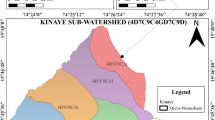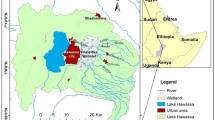Abstract
Hydrological processes in a mixed land use watershed are significantly influenced by land use (LU) and land cover (LC). In order to quantify the effect of LU/LC, topography, and morphology, runoff and sediment yield of a small multivegetated watershed in a sub-humid subtropical region in India were simulated by the Soil and Water Assessment Tool (SWAT) model and were compared with measured values. The mixed land use watershed displayed a synchronized runoff response to monsoon rains. Measured runoff and sediment yield varied one sub-watershed to another and ranged, respectively, from 256.33 to 367.83 mm and from 0.27 to 11.65 t/ha for 734.90 mm of rainfall in 2000 and from 310.36 to 393.49 mm and from 0.84 to 10.71 t/ha for 765.50 mm of rainfall in 2001. The correlation coefficient between rainfall and runoff was 0.86, that between runoff and sediment yield was 0.56, and that between rainfall and sediment yield was 0.55. The sub-watersheds with relatively high forest cover (SWS1 and SWS2) showed significantly less runoff and sediment yield (310.36 mm and 0.84 t/ha), whereas a sub-watershed with more area under cultivation produced higher runoff (393.5 mm) and higher sediment yield (11.65 t/ha). Measured and model simulated estimates of runoff and sediment yield from different sub-watersheds were employed to prioritize control measures in the watershed comprising areas under cultivation, waste, fallow and eroded land, and forest and bushes. The average estimates of sediment yield from different sub-watersheds were used to prioritize the checkdam construction as an effective measure to control sediment transport to downstream water resources.
Similar content being viewed by others
References
Arnold JG, Allen PM (1996) Estimating hydrologic budgets for three Illinois watersheds. J Hydrol 176:57–77
Arnold GJ, Srinivasan R, Muttiah RS, Williams JR (1998) Large area hydrologic modeling and assessment. Part I: model development. J AWRA 34(1):73–89
Bakker MM, Govers G, Kosmas C, Vanacker V, van Oost K, Rounsevell M (2005) Soil erosion as a driver of land-use change. Agric Ecosyst Environ 105:467–481
Basnyat P, Teeter LD, Lockaby BG, Flynn KM (2000) The use of remote sensing and GIS in watershed level analyses of non-point source pollution problems. For Ecol Manag 128:65–73
Bultot F, Dupriez GL, Gellens D (1990) Simulation of land use changes and impacts on the water balance: a case study for Belgium. J Hydrol 114:327–348
Calder IR (1992) Hydrologic effects of land use change, In: Maidment DR (ed) Handbook of Hydrology, pp 13.1–13.5
Choi JY, Engel BA, Chung HW (2002) Daily streamflow modelling and assessment based on the curve-number technique. Hydrol Process 16:3131–3150
Dunjo G, Pardini G, Gispert M (2004) The role of land use-land cover on runoff generation and sediment yield at a microplot scale, in a small Mediterranean catchment. J Arid Environ 57:99–116
EPA (1976) Quality criteria for water. Environmental Protection Agency, Washington, DC
Ewen J, Parkin G (1996) Validation of catchment models for predicting land-use and climate change impacts. I. Method. J Hydrol 175:583–594
Hilhnan GR, Verschuren JP (1988) Simulation of the effects of forest cover, and its removal, on subsurface water. Water Resour Res 24:305–314
Kang MS, Park SW, Lee JJ, Yoo KH (2006) Applying SWAT for TMDL programs to a small watershed containing rice paddy fields. Agric Water Manag 79(1):72–92
Kim CG, Kim HJ, Jang CH, Shin SC, Kim NW (2003) SWAT application to the Yongdam and Bocheong watersheds in Korea for daily stream flow estimation. 2nd SWAT International Conference Proceeding, July 1-4, 2003, Bari, Italy. TWRI Technical Report 266. p 283–292
Mass RP, Smolen MD, Still DA (1985) Selecting critical areas for nonpoint source pollution control. J Soil Water Conserve 40(1):68–71
Naef F, Scherrer S, Weiler M (2002) A process based assessment of the potential to reduce flood runoff by land use change. J Hydrol 267:74–79
Narayana VVD (1993) Soil and water conservation research in India. Indian council of agricultural research, Krishi Anusandhan Bhawan, Pusa, New Delhi, pp 146–151
Parkin G, O’Donnell G, Ewen J, Bathurst JC, O’Connell PE, Lavabre J (1996) Validation of catchment models for predicting land-use and climate change impacts. II. Case study for a Mediterranean catchment. J Hydrol 175:595–613
Sharma T, Satya Kiran PV, Singh TP, Trivedi AV, Navalgund RR (2001) Hydrologic response of a watershed to land use changes: a remote sensing and GIS approach. Int J Remote Sens 22(11):2095–2108
Singh G, Babu R, Narayan P, Bhusan LP, Abrol IP (1992) Soil erosion rate in India. Indian J Soil and Water Cons 47(1):97–99
Tim US, Moostaghimi S, Shanholtz VO (1992) Identification of critical non point pollution source areas using geographic information systems and water quality modeling. Water Resour Bull AWRA 28(5):877–887
USDA Soil Conservation Service (1972) Section 4: hydrology In: National engineering handbook. Washington, D.C
Williams JR, Berndt HD (1977) Sediment yield prediction based on watershed hydrology. Trans ASAE 20:1100–1104
Wooldridge S, Kalma J, Kuczera G (2001) Parameterization of simple semi-distributed model for assessing the impact of land use on hydrologic response. J Hydrol 254:16–32
Author information
Authors and Affiliations
Corresponding author
Rights and permissions
About this article
Cite this article
Mishra, A., Kar, S. & Singh, V.P. Prioritizing Structural Management by Quantifying the Effect of Land Use and Land Cover on Watershed Runoff and Sediment Yield. Water Resour Manage 21, 1899–1913 (2007). https://doi.org/10.1007/s11269-006-9136-x
Received:
Accepted:
Published:
Issue Date:
DOI: https://doi.org/10.1007/s11269-006-9136-x




